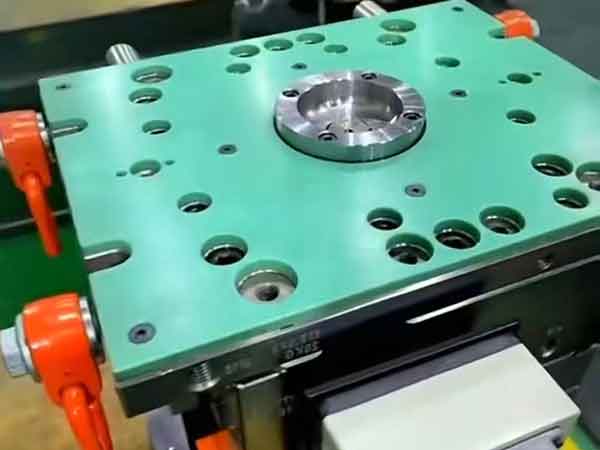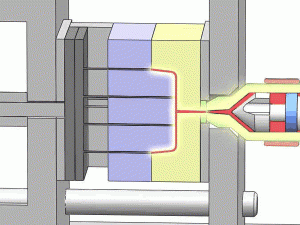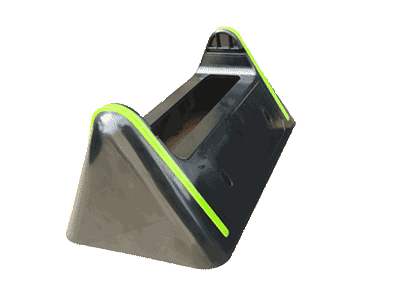Understanding Mold Temperature in Injection Molding
During the injection molding process, the quality and cycle time of the molded product are directly influenced by the mold temperature. Since different resins have varying glass transition and molding temperatures, setting the appropriate mold temperature is crucial. Let’s delve into the comprehensive understanding of mold temperatures in injection molding production.
Recommended Mold Temperatures for Common Plastics
The table below shows the recommended mold temperatures for several commonly used plastics. Although it doesn’t cover a wide range of materials, it provides a general idea of what the mold temperatures should be for typical plastics in injection molding.
For specific types of plastics, material suppliers usually provide detailed temperature recommendations in their material property sheets.
Common Plastic Injection Molding Temperature Reference Table
| Material Name | Mold Temperature (°C) | Melting Temperature (°C) | Injection Molding Temperature (°C) | Decomposition Temperature (°C) |
|---|---|---|---|---|
| ABS | 50-80 | 170-190 | 200-240 | 280 |
| PP (Polypropylene) | 40-80 | 160-175 | 190-290 | 320 |
| POM (Polyoxymethylene) | 80-105 | 165-175 | 190-230 | 280 |
| PC (Polycarbonate) | 80-120 | 225-250 | 270-320 | 360 |
| PBT | 60-80 | 225-235 | 220-270 | 280 |
| PA6 (Nylon 6) | 80-120 | 215-221 | 260-300 | 320 |
| PA66 (Nylon 66) | 80-120 | 260-265 | 270-310 | 360 |
| PMMA (Acrylic) | 50-70 | 160-180 | 220-250 | 270 |
| LDPE (Low-Density Polyethylene) | 30-45 | 110-130 | 150-230 | 300 |
| HDPE (High-Density Polyethylene) | 50-80 | 125-137 | 160-280 | 300 |
| PEEK (Polyether Ether Ketone) | 170-200 | 315-353 | 360-400 | 520 |
This table provides an overview of various plastics along with their recommended mold temperature, melting temperature, injection molding temperature, and decomposition temperature.
Mold Temperature to Mold Cycle Time
It’s apparent that the lower the mold temperature, the shorter the time required for the product to cool and solidify, thus reducing the injection molding cycle. Generally, the cooling phase of injection molding typically takes about 20-70 seconds, occupying the largest proportion of the entire cycle. Consequently, reducing cooling time plays a key role in enhancing productivity and cutting costs.
Moreover, the uniformity of mold temperature, ensuring consistent cooling speed throughout the product, is equally important. This necessitates a well-designed cooling water circuit and, sometimes, even conformal cooling techniques to achieve uniformity.
Mold Temperature to Internal Stresses
There is a close relationship between mold temperature and internal stresses in injection-molded products, mainly manifesting in the following aspects:
Formation of Internal Stresses
Internal stresses primarily arise due to inconsistent thermal shrinkage rates in different parts of the plastic product during the cooling process. This uneven shrinkage generates tension and pressure within the material, leading to internal stresses.
Mold Temperature and Cooling Rate
A higher mold temperature slows down the cooling rate of the melt in the mold. This slower cooling is beneficial in reducing internal stresses caused by rapid and uneven cooling. It allows the material more time to shrink uniformly, thereby reducing internal tension.
Temperature Uniformity
Uniform mold temperature aids in achieving even cooling throughout the product, subsequently reducing the generation of internal stresses. If some areas of the mold are colder or hotter than others, it will lead to uneven material shrinkage and increase internal stresses.
Material Characteristics
Different plastic materials react differently to mold temperature. Crystalline and amorphous plastics behave differently during cooling and solidification, so the formation of internal stresses is also affected differently by mold temperature.
Consequences of Internal Stresses
Internal stresses can lead to instability in product dimensions, cracking, deformation, or deterioration in performance during subsequent processing. Therefore, minimizing internal stresses through appropriate control of mold temperature is crucial.
Mold Temperature to Product Dimensions
The effect of mold temperature on the dimensions of injection-molded products is manifested in several ways:
High Mold Temperature
When the mold temperature is high, the temperature of the plastic product after ejection is also high. This leads to an increased shrinkage rate during cooling, causing the product dimensions to decrease. To compensate for this shrinkage, it is possible to increase the product size by extending the holding time and increasing holding pressure.
Lowering Mold Temperature
To increase the size and stability of the product, lowering the mold temperature is an effective method. A lower temperature can reduce the shrinkage rate of the product, helping to maintain consistency in dimensions.
Temperature Uniformity in Mold
If the temperature varies across different parts of the mold, it leads to uneven cooling speeds and, consequently, varying shrinkage rates. This not only affects the precision of dimensions but can also cause internal stress and warping of the product.
In conclusion, the proper control of mold temperature is key to ensuring the dimensional accuracy and quality of injection-molded products. Adjusting mold temperature effectively controls the product’s shrinkage rate and dimensional stability, ensuring product quality.
Recommended Mold Temperature for Semi-Crystalline Plastics
The selection of the correct mold temperature is crucial for semi-crystalline plastics:
Issues with Low Mold Temperatures
When such plastics are injected at lower mold temperatures, their molecular alignment is restricted, preventing further crystallization. Products molded this way are prone to re-align and crystallize when exposed to high temperatures during use or secondary processing, leading to deformation well below their heat deflection temperature (HDT).
Recommended Practice
It’s advised to produce these plastics at mold temperatures close to their crystallization temperature. Doing so ensures that the products are fully crystallized during the injection molding stage, thereby avoiding post-crystallization and shrinkage that might occur in high-temperature environments.
In summary, choosing the appropriate mold temperature is vital for semi-crystalline plastics. It enhances the quality and stability of the products, preventing deformation and quality degradation in high-temperature conditions.
Issues with Excessive Mold Temperature
When the mold temperature is too high, several problems can arise:
Excessive Flow Leading to Flash
High mold temperatures increase the flowability of the plastic melt, leading to the formation of flash. Flash is the excess thin layer of plastic that spills out over the edges of the mold.
Difficulty in Ejection and Deformation
An overly high mold temperature can make it difficult for the product to form and be ejected from the mold. If the product is ejected at a temperature higher than its heat deflection temperature, it can deform, affecting the quality.
Mold Steel Material Issues
At high temperatures, certain mold steels may undergo excessive thermal deformation, leading to mold “locking” or the inability to open the mold properly. This requires the use of special steels with low thermal deformation for molds operating in high-temperature environments.
Therefore, mold cooling is critical, a vital aspect in the production of most injection-molded products. Proper control of mold temperature not only enhances product quality but also prevents mold damage and ensures smooth production.
Methods of Mold Temperature Control
Mold temperature control in injection molding is primarily categorized into cooling and heating the mold, detailed as follows:
Mold Cooling Methods
There are several methods of cooling injection molds:
Room Temperature Water Cooling: The most common cooling method involves using cooling tower water to cool the mold, bringing the water temperature close to ambient temperature. This method is economical, practical, and suitable for most standard injection molding operations.
Chilled Water Cooling: When faster cooling is required, a chiller is used. By setting the water temperature generally between 13-17°C, mold temperature can be controlled more precisely, suitable for scenarios where high precision and production efficiency are needed.
Air Cooling: In some cases, if the mold temperature easily reaches the working temperature, or if the product does not require strict temperature control, ambient air can be used for cooling. This method does not require connecting cooling water circuits and heating pipes but is less commonly applied, used only under specific conditions.
Mold Heating Methods
Various methods are used to heat injection molds, each with its characteristics and applications:
Temperature Controller Heating: A common method of heating, using temperature controllers that offer water heating and oil heating options. Water heating is suitable for mold temperatures below 100°C, while oil heating is used for temperatures above 100°C. For some high-temperature plastics requiring mold temperatures even up to 200°C, oil heating becomes especially important.
Electric Coil Heating: This is a cost-effective heating method, but its drawback is potential uneven heating, which can affect product quality. Therefore, it might not be suitable for productions where uniform heating is crucial.
Insulation Plates: To improve heating efficiency and reduce thermal loss, some molds use insulation plates. This method helps maintain stable mold temperatures while also reducing energy consumption.

Mold rapid cooling and heating
Mold rapid cooling and heating, also known as “Rapid Heat Cycle Molding” (RHCM), is a specialized treatment technique for injection molding molds. During this process, the mold is quickly heated to a temperature higher than the melting point of the plastic to facilitate plastic flow and fill the mold. Once the plastic fills the mold, the temperature is rapidly lowered to accelerate the plastic’s cooling and solidification, thereby shortening the molding cycle.
The rapid cooling and heating technology is suitable for high-precision products with high surface quality requirements, such as transparent plastic products and high-gloss surface items. This technique demands precise temperature control and an efficient heating and cooling system, setting high standards for mold design and manufacturing.
However, due to its substantial energy consumption during production, its use is limited and typically reserved for special occasions.
Conclusion
In conclusion, understanding and accurately applying mold temperature settings is pivotal in the realm of injection molding. It not only ensures the integrity and quality of the final product but also significantly influences the efficiency of the production process.
From ABS to PEEK, each material demands a nuanced approach to temperature control. By adhering to these guidelines and adapting to the specific requirements of each plastic, manufacturers can achieve superior product quality, minimize defects, and optimize cycle times. Remember, the key to successful injection molding lies in the meticulous management of mold temperatures.



